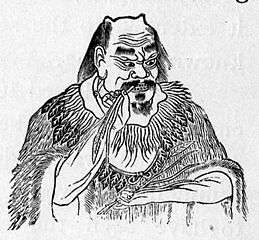Yan Emperor
| Yan Emperor | |||||||||||||
 Shennong tastes herbs to discover their qualities | |||||||||||||
| Chinese | 炎帝 | ||||||||||||
|---|---|---|---|---|---|---|---|---|---|---|---|---|---|
| Literal meaning | Flame Emperor | ||||||||||||
| |||||||||||||
The Yan Emperor was a legendary Chinese ruler in pre-dynastic times. Modern scholarship has identified the Sheep's Head Mountains (Yángtóu Shān) just north of Baoji in Shaanxi Province as his homeland and territory.[1]
A long debate has existed over whether or not the Yan Emperor was the same person as the legendary Shennong. An academic conference held in China in 2004 achieved general consensus that the Yan Emperor and Shennong were the same person.[2] Another possibility is that the term Flame Emperor was a title, held by dynastic succession, with Shennong being known as Yandi, perhaps posthumously. Accordingly, the term Flame Emperors would be generally more correct. The succession of Flame Emperors, from Shennong, the first Yandi, until the time of the last Yan Emperor's defeat by Huangdi (the Yellow Emperor), may have been some 500 years.[3]
Historical records
No written records are known to exist from the era of Yan's reign. However, he and Shennong are mentioned in many of the classic works of ancient China. Yan literally means "flame", and K. C. Wu speculates that this appellation may be connected with the fire used to clear the fields in slash and burn agriculture.[3] In any case, it appears that agricultural innovations by Shennong and his descendants contributed to some sort of social success that lead them to style themselves as di (Chinese: 帝; literally: "emperors"), rather than hou (Chinese: 侯; literally: "lord"), as in the case of lesser leaders. At this time it appears that there were only the bare beginnings of written language, and that for record keeping a system of knotting strings (perhaps similar to quipu) was in use.[4] The Zuo Zhuan states that in 525 BC, the descendants of Yan were recognized as long having been masters of fire and having used fire in their names.[5] Yandi was known as "Emperor of the South"[6]
Downfall
The last Yandi, or Flame Emperor, met his demise in the third of a series of three battles, known as the Battle of Banquan, probably on the Banquan plain, near the southern border of the modern Nei Mongol Autonomous Region, approximately 150 kilometers (about 93 miles) northwest of modern Beijing.[7] Yandi, or the Flame Emperor, was defeated by the rising Huangdi, or the Yellow Emperor.
Historicity
Since the Battle of Banquan is treated historically by Sima Qian in his Historical Records, it would appear that this is a pivotal transition point between mythology and history. Ironically, Yandi enters history only with his 'demise', which it seems was submission to the will of Huangdi, rather than actual physical demise. In any case, the title of Yan di apparently lapsed at this time, while his tribe's descendants were said to be perpetuated through intermarriage with the party of Huangdi (see Descendants of Yan & Huang Emperors).
In traditional culture
Both Huangdi and Yandi are considered in some sense ancestral to Chinese culture and people. Also, the tradition of associating a certain color with a particular dynasty may have begun with the Flame Emperors. According to the Five Elements, or Wu Xing model, red, fire, should be succeeded by yellow, earth—or Yangdi by Huangdi.[8]
List of Flame Emperors
This is the most common list given by Huangfu Mi, Xu Zheng, and Sima Zhen:
| Name | Notes |
|---|---|
| Shennong 神農 | Born Jiang Shinian 姜石年 |
| Linkui 臨魁 | |
| Cheng 承 | |
| Ming 明 | Considered father of Loc Tuc in Vietnamese mythography |
| Zhi 直 | |
| Li 釐 or Ke 克 | Sima Zhen puts Ke between Ai and Yuwang |
| Ai 哀 | Considered father of Au Co in Vietnamese mythography |
| Yuwang 榆罔 | Defeated by Yellow Emperor at Banquan |
List provided at the end of the Shan Hai Jing:
| Name | Notes |
|---|---|
| Yandi 炎帝 | |
| Yanju 炎居 | Also possibly known as Zhu 柱 |
| Jiebing 節並 | |
| Xiqi 戲器 | |
| Zhurong 祝融 | |
| Gonggong 共工 | |
| Shuqi 術器 | |
| Houtu 后土 | Brother of Shuqi |
| Yeming 噎鳴 | Son of Houtu |
| Suishi 歳十 |
See also
- Descendants of Yan & Huang Emperors
- Huaxia
- Shennong
- Three Sovereigns and Five Emperors
- Yao Grass
- Yellow Emperor
- Zhonghua Minzu
References
Citations
- ↑ He Wandan 贺晚旦 and Yang Hongbao 杨红保, in Yan Di Wen Hua 炎帝文化, edited by Wang Shuxin 王树新 and Meng Shikai 孟世凯, (Beijing: Zhonghua Shuju), 3-4.
- ↑ Yang Dongchen 杨东晨, in Yan Di Wen Hua 炎帝文化, 15.
- 1 2 Wu, 56
- ↑ Wu, 56, and note 26, referencing Xu Shen
- ↑ Chinese: 《左轉·左丘明》: "昭公十七年:炎帝氏以火紀,故為火師而火名。"
- ↑ Various (1991). Chinese America: History and Perspectives 1991. Chinese Historical Society. p. 64. Retrieved 2012-04-01.
- ↑ Wu, 57
- ↑ Wu, 56-57
Sources
- Yan Di Wen Hua [《炎帝文化》], (2005). Edited by Wang Shuxin [王树新], Meng Shikai [孟世凯]. Beijing: Zhonghua Shuju [中华书局]. ISBN 7-101-04854-4.
- Wu, K. C. (1982). The Chinese Heritage. New York: Crown Publishers. ISBN 0-517-54475-X.
| Regnal titles | ||
|---|---|---|
| Preceded by Fuxi |
Chinese sovereign | Succeeded by Yellow Emperor |
